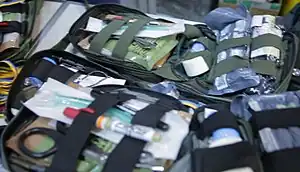Emergency Bandage

The Emergency Bandage or Israeli bandage is a specially designed, first-aid device that is used to stop bleeding from hemorrhagic wounds caused by traumatic injuries in pre-hospital emergency situations.[1][2] First used for saving lives during a NATO peacekeeping operation in Bosnia and Herzegovina, the bandage was successfully used during operations Enduring Freedom and Iraqi Freedom.[1][2] The bandage was nicknamed "Israeli bandage" by American soldiers,[3] and has been "the bandage of choice for the US Army and special forces."[2] The Israeli Bandage was included in the first aid kits of emergency personnel and first responders at the 2011 Tucson shooting, and was used to treat some victims of the shooting.[1][4]
The bandage was invented by an Israeli military medic, Bernard Bar-Natan.[5]
Background
For years, one of the most preventable causes of death in non-fatally wounded people has been the inability to quickly and effectively stop bleeding.[3] Military doctors Nolan Shipman and Charles S. Lessard write in Military Medicine journal that "[t]he first step in containing seriously wounded casualties is to control the hemorrhage as much as possible."[2] In the era preceding Operation Enduring Freedom (OEF) and Operation Iraqi Freedom (OIF), US military medics would take wounded soldiers from battlefields to hospitals for treatment. This often resulted in prolonged and irreversible loss of blood. Today, the tactic of caring for wounded soldiers has changed and the wounds are treated in the battlefield. The Israeli Bandage, which can be applied with only one hand, successfully stops bleeding and has been used by the armies of the United States, Germany, Australia, New Zealand, and other countries.[3] David Kleinman, a SWAT team medic who devised a first aid kit used to treat victims of the 2011 Tucson shooting, said that "deputies reached for the Emergency Bandage 'over and over at the scene'" of the shooting.[4]
History of development
When the bandage's inventor, Bernard Bar-Natan, was in training to become an Israeli military medic in 1984, he noticed that the bandages issued for bleeding control had a manufacture date of 1942 or sometimes even 1938. He also noticed that more current styles had the same design and the same features as 1942 bandages.[1][6] The trainees were advised to grab a stone and to use it to apply pressure to a wound that would not clot on its own. Bar-Natan started work on a new generation of bandages that would not rely on the "grab a stone" approach, but would have a pressure bar built into the bandages themselves.[1]
In 1990–1991, the idea and the design were developed enough to apply for Israeli Government support from the Office of the Chief Scientist in the Ministry of Industry. The application allowed Bar-Natan to become a part of a technology incubator program in Jerusalem's Har Hotzvim, with a government grant covering 3/4 of the expenses connected to the research and development of the bandage.[1] After three additional years of development the bandage was ready for commercialization.[1] However, Bar-Natan formed First Care Products Ltd and supervised the design and production of the bandage.
A Belgian medical equipment distributor bought the first bandages in 1998.[1] Bar-Natan, having grown the company to a profitable entity, later sold it to PerSys Medical in Houston, Texas, the company that first introduced the bandage to the US military. Today 1.5 to 2 million bandages are produced and sold each year. [1]
Features
The Emergency Bandage is an elasticized bandage with a sewn-in non-adhesive pad.

They are similar to elastic bandages used to treat sprain injuries, but have three unique features:
- A sterile non-adherent dressing to allow removing the bandage without reopening a wound.[2]
- A pressure applicator placed over the wound to stop bleeding by applying pressure.[2] It allows changing the direction of the bandage and wrapping it around the wound once in various directions. It also makes bandaging easier. It is especially useful for stopping bleeding in groin and head injuries.[3]
- A closure bar at the end of the bandage to secure the bandage and add pressure to a wound. It allows the bandage to clip neatly in place without slipping[3] and can be used by a "sliding motion with one hand."[2]
Newer versions, such as T3 and the 9T, include features such as gauze for additional wrapping, extra pads, abdominal pads to cover eviscerations, and moisture seals to cover wounds and burns.
The bandages come in three sizes: 4, 6, and 8 inches wide.[2]
The bandage was favorably reviewed in the Military Medicine journal.[2]
See also
- Antihemorrhagic
- Field dressing (bandage)
- Israeli inventions and discoveries
References
- 1 2 3 4 5 6 7 8 9 David Horowitz (2011-04-29). "Editor's Notes: The guy with the bandage". The Jerusalem Post. Retrieved May 17, 2011.
- 1 2 3 4 5 6 7 8 9 Nolan Shipman; Charles S Lessard (January 2009). "Pressure Applied by the Emergency/Israeli Bandage" (PDF). Military Medicine. pp. 86–92(7). Retrieved April 4, 2011.
- 1 2 3 4 5 Nicky Blackburn (January 9, 2005). "Israeli innovative bandages saving American lives in Iraq". israel21c. Retrieved April 4, 2011.
- 1 2 Sandhya Somashekhar; Sari Horwitz (2011-01-21). "First-aid kits credited with saving lives in Tucson shooting". The Washington Post. Retrieved May 17, 2011.
- ↑ "Editor's Notes: The guy with the bandage". The Jerusalem Post.
- ↑ Ron Kampeas (February 17, 2011). "'Israeli bandage' may have saved Giffords' life after shooting". j. Retrieved April 4, 2011.